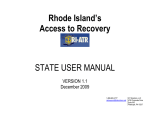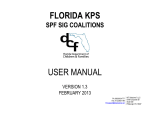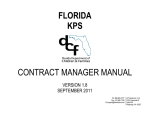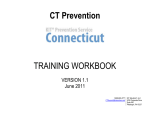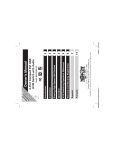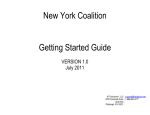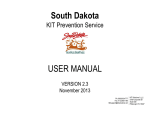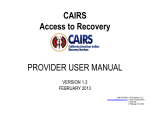Download North Carolina LME USER MANUAL
Transcript
North Carolina Prevention Outcomes Performance System LME USER MANUAL VERSION 1.2 December 2010 1-888-600-4777 [email protected] KIT Solutions®, LLC 5700 Corporate Drive Suite 530 Pittsburgh, PA 15237 TABLE OF CONTENTS Tips for Using the Application Effectively................................................................................................................................................................................................................ 4 Recommended Computer Settings .................................................................................................................................................................................................................... 4 Application Navigating........................................................................................................................................................................................................................................ 5 Menu Information........................................................................................................................................................................................................................................... 5 Understanding the Landing Page .................................................................................................................................................................................................................. 7 Using the Listing Page................................................................................................................................................................................................................................... 8 Edit Forms ................................................................................................................................................................................................................................................... 10 Data Fields and Buttons................................................................................................................................................................................................................................... 11 Edit Form Buttons ........................................................................................................................................................................................................................................ 13 Additional Buttons........................................................................................................................................................................................................................................ 14 Login Procedure ................................................................................................................................................................................................................................................... 17 Forgot Password? ............................................................................................................................................................................................................................................ 18 Home.................................................................................................................................................................................................................................................................... 19 Assessment.......................................................................................................................................................................................................................................................... 21 Data Sources ................................................................................................................................................................................................................................................... 21 Problem Statements......................................................................................................................................................................................................................................... 23 Capacity ............................................................................................................................................................................................................................................................... 25 Planning ............................................................................................................................................................................................................................................................... 26 Choose Targeted Factors................................................................................................................................................................................................................................. 26 Goals/Objectives .............................................................................................................................................................................................................................................. 28 Viewing Goals.............................................................................................................................................................................................................................................. 28 Viewing Objectives ...................................................................................................................................................................................................................................... 30 Programs ......................................................................................................................................................................................................................................................... 31 Viewing Programs........................................................................................................................................................................................................................................ 31 Reports................................................................................................................................................................................................................................................................. 32 Opening a Report............................................................................................................................................................................................................................................. 32 Using Reports that require Additional Data.................................................................................................................................................................................................. 34 Printing or Saving Reports ........................................................................................................................................................................................................................... 35 Knowledge Base................................................................................................................................................................................................................................................... 36 Web Sources.................................................................................................................................................................................................................................................... 36 Communication..................................................................................................................................................................................................................................................... 38 Events Calendar............................................................................................................................................................................................................................................... 38 Events Manager ............................................................................................................................................................................................................................................... 40 Adding an Event .......................................................................................................................................................................................................................................... 40 North Carolina LME User Manual 2 © KIT Solutions® 2010 Editing an Event........................................................................................................................................................................................................................................... 42 Deleting an Event ........................................................................................................................................................................................................................................ 43 Administration....................................................................................................................................................................................................................................................... 44 Organization..................................................................................................................................................................................................................................................... 44 Viewing the Organization Information .......................................................................................................................................................................................................... 44 Staff.................................................................................................................................................................................................................................................................. 45 Adding a Staff Member ................................................................................................................................................................................................................................ 45 Permissions ................................................................................................................................................................................................................................................. 48 Editing a Staff Member ................................................................................................................................................................................................................................ 49 Deleting a Staff Member .............................................................................................................................................................................................................................. 50 Admin............................................................................................................................................................................................................................................................... 51 Editing Admin Time...................................................................................................................................................................................................................................... 52 Deleting Admin Time.................................................................................................................................................................................................................................... 54 Change Password............................................................................................................................................................................................................................................ 55 Support................................................................................................................................................................................................................................................................. 56 North Carolina LME User Manual 3 © KIT Solutions® 2010 TIPS FOR USING THE APPLICATION EFFECTIVELY Recommended Computer Settings Screen Resolutions You will get the best screen layout if you set your PC monitor settings to 1024 X 768 or larger. If your screen resolution is smaller (e.g., 800 x 600 pixels), everything on the screen will appear larger. But, if you use 800 x 600 pixels you will have to scroll more both up and down and left and right to access all the data fields. To change your PC monitor settings, right click on the Desktop background and select Properties. Next, click on the Settings tab and move the Screen Resolution scroll bar to the right (towards “more”) to select 1024 X 768 resolution. Click the OK button at the bottom of the window to make the change effective. Web Browser The web browser supported by North Carolina POPS (Prevention Outcomes Performance System) is Microsoft Internet Explorer (IE). Mozilla Firefox, Netscape, Safari and other browsers may not be supported by North Carolina POPS. They may function but not to design specifications. We recommend users have the latest version of IE installed on their computer along with the updates provided by Microsoft (which are released periodically). Pop-Up Blockers Modern computer security technology and usability features development have led to pop-up blocking. Although this new feature of Internet browsers, toolbars and other 3rd party managing software blocks hazardous and annoying pop-ups, sites like the North Carolina POPS require pop-ups to be able to function. If your pop-up blocker is enabled, then there is a possibility that North Carolina POPS may not function or appear properly. You should either disable the pop-up blocker while using the NC POPS (while remembering to enable it, if desired, when not using the North Carolina POPS) or create exceptions for the pop-up blocker. Although enabling and disabling the pop-up blocker may be cumbersome, it may be easier than making exceptions to the pop-up blocker. To create exceptions for the pop-up blocker, open your internet browser window. If using Internet Explorer, click the top toolbar option “Tools” and then go to “Internet Options”. After the Internet Options window is available, you will want to click on the “Privacy” tab at the top of the window. You will notice while on the “Privacy” tab at the bottom will be a section on Pop-Up Blockers. If you “Block pop-ups” checkbox is checked, click on the “Settings” button to allow for exceptions. You can now add the NC POPS links to the “Allowed Sites” list which the pop-up blocker will ignore when trying to block pop-ups from the North Carolina POPS. You will want to add https://kitservices2.kithost.net/ for the Live system and http://demo.kithost.net/ for the Training system. Once these sites are added to your “Allowed Sites” list, the pop-up blocker should no longer prevent pages from loading and appearing while you are using the North Carolina POPS. *Note: These are instructions for Internet Explorer 7.0 and may be different for other Internet Explorer versions. North Carolina LME User Manual 4 © KIT Solutions® 2010 Application Navigating North Carolina POPS is set up in such a fashion that moving from Left to Right on the menu is the best approach to using the application. Start at Assessment, filling in all the information for that area before moving on to the Planning section. Continuing in this manner will ensure that all of the sections of the application have enough information to function correctly. If all of the different portions are not completed, some modules will not work correctly. Menu Information The Menu for the service is located across the top of the screen. Some Menu categories may be broken down into submenu categories to choose from. The Menu categories list the main modules that are within the application. When a Menu category is selected a list of submenu categories will be displayed on the Landing Page as links to access the modules. (For more information on Landing Pages, see the Landing Page section.) 1. Menu Constant (unchanging). Available at all times. 2. Landing Page Varies depending on which Menu category is selected. Displays the Submenu Categories. 3. Submenu Category Varies depending on which Menu category is selected. 4. Listing Page Varies depending on which Submenu Category is selected. 1. Menu 4. Listing Page 2. Landing Page and 3. Submenu Category list (This is a sample screenshot displaying a Listing Page (4)) (This is a screenshot displaying the Menu (1), a Landing Page (2) and a Submenu Category list (3)) North Carolina LME User Manual 5 © KIT Solutions® 2010 Link to Home page The top of the menu provides links to the (Home) page and to (Log Out) of the application. The Provider ID number is listed as well as the user currently logged into the application. User currently logged in Provider ID number Link to Log Out Bread Crumb Trail Bread Crumb Trail A “Bread Crumb Trail” is provided to indicate where you currently are in the application. The links provided in the Bread Crumb Trail also allows you to move backwards in the application. North Carolina LME User Manual 6 © KIT Solutions® 2010 Understanding the Landing Page When first entering a module you may see a list of the entire categories associated with that module. This is called a “Landing Page”. The Landing Page of a module provides a description of what can be done in that module as well as listing each category as a link to the Listing Page and entry forms. (For more information on the Listing Pages, see the Using the Listing Page section.) No data is entered on the Landing Page. To open a category: • Click on the Landing Page Submenu Category link. Submenu Category link (This is a screenshot displaying a Landing Page) North Carolina LME User Manual 7 © KIT Solutions® 2010 Using the Listing Page After selecting a category from the Landing Page you will see the “Listing Page”. When going into an area where a Listing Page is available, the service allows you to select previously entered data to edit or view its content. No data is entered on the Listing Page. Understanding the Grid View The Grid View displays the data in tables. Specific pieces of data will be displayed within the Grid based on the fields within the entry/edit form. 1. When first viewing a Listing Page, all of the data is available for Searching. Click the (Select) link to the left of the data you would like to edit/view. 2. You will be taken to the entry/edit screen. This page will be in edit mode (all data fields will be open for data entry). Make any changes needed to the form. (Save) button to save the changes. Click the Grid View (This is a sample screenshot displaying a Listing Page) Tips • • Clicking on the field name in a Category field (e.g., ) will allow you to sort through your files in ascending or descending order. The Page numbers (e.g. ) beneath the grids allows to you move from page to page within the specific listing page. There is a maximum of 8 items in a grid, so once you exceed 8, the application automatically updates the grid to page 2. To get to a desired page click on the number and you will go to that specified page. North Carolina LME User Manual 8 © KIT Solutions® 2010 Advanced Search • Click the entered. (Show All) radio button to see a list of all data that has been Show All (This is a sample screenshot of a Data Grid displaying the Advanced Search tab.) • To filter a search, click the the Grid. Advanced Search tab (Advance Search) tab located at the top of (This is a sample screenshot of the Advanced Search displaying the Choose From All option selected.) • • Once you have selected the Advanced Search feature, you will need to select a Category from the dropdown list. Then select an option from the three search filter fields. Once the three search filter fields have been selected, click the (Go) button to see the search results. The three search filter fields are used in the following methods: 1. The first search filter will display the search categories to choose from. 2. The second search filter allows you to specify how you wish to search. 3. The third search filter is the search criteria. This field will change based on the second search filter selected. North Carolina LME User Manual Filters (This is a sample screenshot of Advanced Search displaying the Or Select a Filter option selected.) 9 © KIT Solutions® 2010 Edit Forms The Edit Form contains the fields for entering and editing data. The buttons for saving, cancelling, deleting, printing, and in some cases, adding and editing, are available. (See the Data Fields and Button section for additional details on the function of these buttons.) • • (Add) button to enter new information into a form, the If you clicked the Edit Form data fields will be blank. When selecting the (Select) link to view existing data, the Edit form data fields will display the data entered/selected previously. These fields may be modified, if needed. (This is a sample screenshot displaying an Edit Form.) Computer Keys While entering information into a form, several keys are helpful for moving the cursor from one information box (called a data field) to another. The table below summarizes those keys: Key Description Function The Cursor Points to desired location The TAB key Moves the cursor to the next data field Hold down the SHIFT key and then press the TAB key Moves the cursor to the previous data field The Control (Ctrl) key Enables blocked material to open (due to pop-up blocker) Use the MOUSE by pointing and clicking to move the cursor Moves the cursor by pointing and clicking North Carolina LME User Manual 10 © KIT Solutions® 2010 Data Fields and Buttons In the North Carolina POPS there are several fields, boxes and buttons that are used to collect and store data. Type Preview/Description Text Field (aka Text Box) (fill in the blank) Dropdown List (aka Pull Down Menu) (select one) Radio Buttons Selected Not Selected Check Boxes Selected Not Selected A yellow box around a field denotes a required field Site Map Displays all of the modules and Submenu Categories of the NC POPS It does not matter the order in which the above fields are filled in, but if a required field is not filled in and you try to save the form, you will receive a message informing you what field is missing data and you will not be able to save the form until that field has data. Tips • All the fields within a yellow box are required fields. These must have a value entered before the record can be saved. • You can type an identifying letter of an item in a dropdown list and the first selected beginning with that letter will appear in the box. North Carolina LME User Manual 11 © KIT Solutions® 2010 SiteMap The SiteMap displays a list of the modules and links that are available within the application. If you click on an available link, you are taken directly to the Listing page. • To view the SiteMap, click on the link entitled (Show SiteMap). Show SiteMap link (This is a partial screenshot of the Home page.) Hide SiteMap link • Once the SiteMap is open, click on the close the table. (Hide SiteMap) link to (This is a sample screenshot of the SiteMap on the Home Page.) North Carolina LME User Manual 12 © KIT Solutions® 2010 Edit Form Buttons Information is entered and edited on the computer screen through data entry/edit forms. The table below summarizes the buttons used to enter/edit information located to the left of each form. This is referred to as the “left toolbar”. Searches for information on the criteria (e.g. staff name) that you specify Must be pressed first to add new information to a form Allows the Edit Form fields to be “open” for modifications Adds the information on a form to the NC POPS database Prints the information currently on the form Displays the Expert Help screen Returns you to previous screen Removes the information currently on a form from the database Cancels the Add or Edit without saving any information entered North Carolina LME User Manual 13 © KIT Solutions® 2010 Additional Buttons Each page within the North Carolina POPS offers additional help to the user. Click on one of the icons to receive the help needed. Prints the information currently on the form. The Chat feature enables users to get immediate assistance from the Customer Support department through an instant messaging system. Below are some additional buttons that may appear within a form. Downloads the selected file into the desired format. Opens the information in the enter/edit form for viewing or modifications Expands the list of available items. Closes the list of available items. Returns selected item to list of available items. Opens an Excel spreadsheet displaying the information on the Listing Page Opens a Word document displaying the information on the Listing Page Changes the text size by clicking on the radio button in front of the desired test size. (For more information, see the Settings section) Denotes a Note with more information regarding a field Identifies potential errors in text and provides suggestions to correct the errors. North Carolina LME User Manual 14 © KIT Solutions® 2010 Check Spelling A Spell Check feature helps eliminate spelling errors. The Spell Check feature will look at any words written within a text box or field and give alternative spelling options to choose from. When the (Check Spelling) button has been selected, a new window opens displaying the Check Spelling Page. (This is a sample screenshot of the Check Spelling page.) Option Description When the (Change) button is clicked, the value in the Change to box will replace the highlighted misspelled word and the Spell Checker will continue to the next word. You may type in this field if an appropriate suggestion is not present in the Suggestions dropdown. A dropdown list of spelling suggestions for the misspelled word. If the word is misspelled but not available as an option in the Suggestions dropdown, you may type the correct spelling in the Change to box. Disregards the misspelling in the highlighted word only and continues to the next word. The next occurrence of the misspelled word will be highlighted for correction. Disregards the misspelling in the highlighted word and all future occurrences of the word. You will no longer be prompted to fix the spelling. An example when to use this is if your name was highlighted as misspelled. Changes the spelling of the highlighted word to the selected Change to word. Changes the spelling of the highlighted word to the selected Change to word and all other occurrences of the word. Closes the Check Spelling window. North Carolina LME User Manual 15 © KIT Solutions® 2010 Settings You can alter the size of the text on a form by using the (Settings) option. Clicking on one of the (Radio) button changes the text size from smallest to largest. Provides the smallest text size Provides a medium(default) text size Provides the largest text size 1. Click the (Settings) button. 2. Select the Text Size by selecting the appropriate radio button. 3. Click the (Set) button. *Note: Click the (Cancel) button to cancel the changes. Chat Feature The Chat feature enables users to get immediate assistance from the Customer Support department. When the (Chat) button has been selected, a new window opens prompting you to run the LogMeInRescue application. You must run this application in order to utilize the chat feature. (This is a sample screenshot of the Run the LogMeInRescue message.) Tips • You will need to install the LogMeIn applet in order to connect with Support. This is a free download. • The installation may take a few minutes. North Carolina LME User Manual 16 © KIT Solutions® 2010 LOGIN PROCEDURE Connect to the Internet using an Internet browser. In the Address field, type in the following address and press enter: Live Data: https://kitservices2.kithost.net/ncprevent2010/ 1. 2. 3. 4. Demo Data: http://demo.kithost.net/ncprevent2010/ Type the login name provided by your acting administrator in the User ID field. Type the password in the Password field. Type the provider number in the Organization ID field. Click the (Login) button. Login button To log out of the application, click the (Log Off) link in the upper right hand corner. (Login Screen) *Notes: Announcements pertaining to scheduled maintenance are displayed on the Login screen. On the Login screen, you can select the Live version of the application or you can select the DEMO version which allows for entering data on a practice. To obtain DEMO login information, contact KIT Support. Tips • • The User ID IS NOT case sensitive. The Password IS case sensitive. • Login information is provided by the Acting Administrator. North Carolina LME User Manual 17 © KIT Solutions® 2010 Forgot Password? If you are unable to log into the NC POPS due to forgetting your User ID or Password, you can retrieve this information by clicking the link entitled “I forgot my Password!” Forgot Password link 1. Type the login name provided by your acting administrator in the User ID* field. 2. Click the (Send It!) button. *Note: Click the (Cancel) button to cancel the request. Send It! button *Note: You will receive an email with your login information as long as the email address entered matches the email address provided in the Staff module. (Forgot Password? Screen) Tips • You must be previously registered for Forgot Password feature to work. North Carolina LME User Manual 18 © KIT Solutions® 2010 HOME The Home page provides the organization with important messages, upcoming events and links to News regarding prevention. Message Title Messages The Message section on the Home page is used post announcements. • To open a Message, click on the (plus sign) next to the Message title. The (plus sign) will become a (minus sign). To close the description, click on the (minus sign). *Note: Messages displaying on the Home page are entered at the state level. (This is a partial screenshot of the Home page displaying an open Message.) Events The Events link entitles you to see a full month’s display of events. • To view entered Events, click on the link entitled My Calendar to see a full month’s display of Events. My Calendar link *Note: The Events are added to the Home page from the Communications module. See Events Manager for instructions. (This is a partial screenshot of the Home page.) North Carolina LME User Manual 19 © KIT Solutions® 2010 Getting Started • • • To view a guide through the initial steps of using the NC POPS application, click on the Launch “Getting Started” Help link. A new window will open displaying some basic information about the NC POPS application. To close the window, click on the (X) in the upper right hand corner or click the (Close) link. North Carolina LME User Manual Getting Started link 20 © KIT Solutions® 2010 ASSESSMENT The Assessment module allows the Local Management Entity (LME) to view the available data sources and problem statements of their specified organizations. Data Sources This section provides sources of secondary data to assist the user in the needs assessment process. 1. Click Assessment from the Menu. 2. Click Data Sources from the Assessment Landing Page. Data Source link (This is a screenshot of the Assessment Landing Page.) 3. 4. 5. 6. Browse the Data Source list for the website or document you would like to view. Click the Data Source link to open the website or document. A new window will open displaying the website or document selected. To close the new window, click the (X) in the upper right corner. Data Source link (This is a partial screenshot of the Data Sources Listing Page.) North Carolina LME User Manual 21 © KIT Solutions® 2010 Tips • • • If you have a pop-up blocker on your computer, hold the CTRL (control) key on your keyboard down while selecting the link used to view the website or document. The left side of the table displays the Data Sources link and the right side of the table is the description of the Data Source. Clicking on the field name in a Category field (e.g., ) will allow you to sort through the Data Sources in ascending or descending order. North Carolina LME User Manual 22 © KIT Solutions® 2010 Problem Statements This section allows you to view the problem statements of specified providers. 1. Click Assessment from the Menu. 2. Click Problem Statements from the Assessment Landing Page. Problem Statements link (This is a screenshot of the Assessment Landing Page.) 3. The LME field is automatically populated. 4. Select the provider from the Organizations dropdown list. *Note: All is the defaulted view. If viewing a particular provider, select the provider from the dropdown list. 5. Select the Fiscal Year from the dropdown list. *Note: All is the defaulted view. If viewing a particular Fiscal Year, select the year from the dropdown list. 6. To select the Problem Statements use the statements. arrows to display the available *Note: All is the defaulted view. a. Click on the *Note: Click the (Select) link to view a particular Problem Statement. (Clear) link to clear the current selection. 7. Click the (View) button to generate the report. a. The information will display on the screen. (See the Reports section to print or save a report.) View button (This is a sample screenshot of the Problem Statements page.) North Carolina LME User Manual 23 © KIT Solutions® 2010 The following table summarizes the arrow buttons: Button Function Minimizes list of options Expands list of options North Carolina LME User Manual 24 © KIT Solutions® 2010 CAPACITY This module is currently under construction. North Carolina LME User Manual 25 © KIT Solutions® 2010 PLANNING The Planning module allows LMEs to view the Risk and Protective Factors, the Goals and Objectives and the Programs that have been entered for specified providers. Choose Targeted Factors This section allows you to view the risk and protective factors of specified providers. The risk and protective factors come from your prevention planning coalition 1. Click Planning from the Menu. 2. Click Choose Targeted Factors from the Planning Landing Page. Choose Targeted Factors link (This is a screenshot of the Planning Landing Page.) 3. The LME field is automatically populated. 4. Select the provider from the Organizations dropdown list. *Note: All is the defaulted view. If viewing a particular provider, select the provider from the dropdown list. 5. Select the Fiscal Year from the dropdown list. *Note: All is the defaulted view. If viewing a particular Fiscal Year, select the yearfrom the dropdown list. 6. Click the (View) button to generate the report. a. The information will display on the screen. (See the Reports section to print or View button save a report.) (This is a sample screenshot of the Choose Targeted Factors page.) North Carolina LME User Manual 26 © KIT Solutions® 2010 The following table summarizes the arrow buttons: Button Function Minimizes list of options Expands list of options North Carolina LME User Manual 27 © KIT Solutions® 2010 Goals/Objectives The Goals and Objectives area allows you to view the goals that have been set throughout the fiscal year and the objectives that will link to the programs and the activities. Viewing Goals 1. Click Planning from the Menu. 2. Click Goals/Objectives from the Planning Landing Page. Goal/ Objectives link (This is a screenshot of the Planning Landing Page.) North Carolina LME User Manual 28 © KIT Solutions® 2010 3. The LME field is automatically populated. 4. Select the provider from the Organization dropdown list. *Note: All is the defaulted view. If viewing a particular provider, select the provider from the dropdown list. 5. Select the Fiscal Year from the dropdown list. *Note: All is the defaulted view. If viewing a particular fiscal year, select the year from the dropdown list. 6. To select the Problem Statements use the Statements. arrows to display the available *Note: All is the defaulted view. a. Click on the *Note: Click the (Select) link to view a particular Problem Statement. (Clear) link to clear the current selection. 7. To select the Goals use the *Note: All is the defaulted view. a. Click on the *Note: Click the arrows to display the available Goals. (Select) link to view a particular Goal. (Clear) link to clear the current selection. 8. Click the (View) button to generate the report. a. The information will display on the screen. (See the Reports section to print or View button save a report.) (This is a sample screenshot of the Goals/Objectives page.) The following table summarizes the arrow buttons: Button Function Minimizes list of options Expands list of options North Carolina LME User Manual 29 © KIT Solutions® 2010 Viewing Objectives 1. From the Goals/Objectives Landing Page, click on the button. 2. The LME field is automatically populated. 3. Select the provider from the Organizations dropdown list. (Objectives) *Note: All is the defaulted view. If viewing a particular provider, select the provider from the dropdown list. 4. Select the Fiscal Year from the dropdown list. *Note: All is the defaulted view. If viewing a particular Fiscal Year, select the year from the dropdown list. 5. To select the Problem Statements use the Statements. arrows to display the available *Note: All is the defaulted view. a. Click on the *Note: Click the (Select) link to view a particular Problem Statement. (Clear) link to clear the current selection. 9. To select the Goals use the *Note: All is the defaulted view. a. Click on the *Note: Click the arrows to display the available Goals. (Select) link to view a particular Goal. (Clear) link to clear the current selection. 10. To select the Objectives use the *Note: All is the defaulted view. arrows to display the available Objectives. View button a. Click on the (Select) link to view a particular Objective. 11. Click the (View) button to generate the report. a. The information will display on the screen. (See the Reports section to print or (This is a sample screenshot of the Objectives Page.) save a report.) 12. To return to the Goals Listing Page, click the (Goals) button. The following table summarizes the arrow buttons: Button Function Minimizes list of options Expands list of options North Carolina LME User Manual 30 © KIT Solutions® 2010 Programs The Program module allows you to view the program information that the providers have entered. Viewing Programs 1. Click Planning from the Menu. 2. Click Programs from the Planning Landing Page. Programs link (This is a screenshot of the Planning Landing Page.) 3. Click the (Search) button from the left toolbar to locate the Program you would like to view. (For additional instructions on searching, see the Advanced Search section.) 4. The selected Program will be displayed. (This is a sample screenshot of the Programs page. This is a partial screenshot.) Tips • To view a specific provider’s Programs, use the Reports section. North Carolina LME User Manual 31 © KIT Solutions® 2010 REPORTS The Reports section of North Carolina POPS has several categories of reports available for use. Administration – This section contains provider and staff contact information as well as staff time. Assessment – This section contains reports specific to the problem statements. Implementation – This section contains reports that draw data involving the services attached with various activities, programs and which staff members are participating with the various services. Planning - This section contains reports on the problem statements and goals and objectives associated with specific providers. Opening a Report 1. Click Reports from the Menu. 2. Click on the radio button to the left of the desired Report Type on the Reports Listing Page. Radio button (This is a screenshot of the Reports Listing Page.) North Carolina LME User Manual 32 © KIT Solutions® 2010 3. Click the (Select) button to the right of the Report Name. Select button (This is a screenshot of the Reports Listing Page.) 4. Select the appropriate report options you desire (parameters). 5. Click the (Show Report) button. Show Report button (This is a screenshot of the Reports Filter page.) North Carolina LME User Manual 33 © KIT Solutions® 2010 Tips • • If you have a pop-up blocker on your computer, hold the CTRL (control) key down on your keyboard while selecting any button used to view the reports. When the (Save these selections for other reports) checkbox is selected, your report selections will be saved. When the New Report) button is clicked, you will no longer have to re-enter all selections. The previous selections remain and may be kept or modified as you need. (Select Using Reports that require Additional Data Some reports will load immediately when the (Show Report) button is clicked on. Others require additional information to be entered first, such as date range. Select New Report button 1. Select the appropriate report selections you desire (parameters). a. You can also leave the Time Period as Select One and enter a Begin Date and End Date on the mm/dd/yyyy format. 2. Select the LME from the dropdown list. Show Report button *Note: Your organization name is the defaulted view. 3. Select the Organization from the dropdown list. (This is a sample screenshot of the Reports Filter page.) *Note: All is the defaulted view. 4. 5. 6. 7. Click the (Show Report) button to generate the report. A new window will open with displaying the selected report. To close the window, click the (X) in the upper right corner. To return to the Reports Listing Page, click the (Select New Report) button and you will return to the Reports Landing Page. Tips • When the (Save these selections for other reports) checkbox is selected, your report selections will be saved. When the New Report) button is clicked, you will no longer have to re-enter all selections. The previous selections remain and may be kept or modified as you need. North Carolina LME User Manual 34 (Select © KIT Solutions® 2010 Printing or Saving Reports Once you have clicked the (Show Report) button, you will then see a print preview screen. This screen is used to only view the data (you cannot print or save from this screen). If you would then like to print or save the report, click the (Export) button to view that file as a PDF. Export button 1. Once you have clicked the (Export) button a message box will appear asking if you would like to open or save the report. 2. Click Open to open the report immediately. The report will open in a new window. 3. Click the print button or to print the report. 4. Click the disk button or to save the report. *Note: You do not have to save the report to print. (This is a sample screenshot of a Report.) Tips • If you have a pop-up blocker on your computer, hold the ctrl key down while selecting any button used to view the reports. North Carolina LME User Manual 35 © KIT Solutions® 2010 KNOWLEDGE BASE The Knowledge Base module is a warehouse of documents and web source information designed to provide pertinent data. Web Sources The Web Sources section of Knowledge Base is useful for finding a wealth of prevention websites. 1. Click Knowledge Base from the Menu. 2. Click Web Sources from the Knowledge Base Landing Page. Web Sources link (This is a screenshot of the Knowledge Base Landing Page.) 3. 4. 5. 6. 7. Select a category from the Choose Category dropdown list. Browse the Web Sources List for the website you would like to visit. Click on the website address link of the Web Source. A new window will open displaying the Web Source you chose. To close the new window, click on the (X) in the upper right hand corner. Web Source link (This is a partial screenshot of the Web Sources page.) North Carolina LME User Manual 36 © KIT Solutions® 2010 Tips • • • If you have a pop-up blocker on your computer, hold the CTRL (control) key down on your keyboard while selecting any button used to view the reports. The left side of the column displays the Web Sources and the right side of the column is the Web Address link for the Web Source. Clicking on the field name in a Category field (e.g., ) will allow you to sort through the Web Sources in ascending or descending order. North Carolina LME User Manual 37 © KIT Solutions® 2010 COMMUNICATION The Communication module is where events that are prevention related are entered. Events Calendar The Events Calendar allows you to enter events into the Calendar to be viewed on the Home Page. Only prevention related events should be placed on the Calendar. 1. Click Communication from the Menu. 2. Click Events Calendar from the Communication Landing Page. Events Calendar link (This is a screenshot of the Communication Landing Page.) North Carolina LME User Manual 38 © KIT Solutions® 2010 Event details 3. A new screen will appear displaying the Calendar. 4. To view Event details for a particular day, click on the calendar date. 5. Switch to the previous or upcoming month by selecting the month link located to the right or left of the month’s name. (This is a sample screenshot of the Events Calendar.) North Carolina LME User Manual 39 © KIT Solutions® 2010 Events Manager The Events Manager allows you to enter events that display in the Events Calendar. Only prevention related events should be placed on the Calendar. Adding an Event 1. Click Communication from the Menu. 2. Click Events Manager from the Communication Landing Page. 3. Click (Add) button from the left toolbar. Events Manager link (This is a screenshot of the Communication Landing Page.) 4. Enter a title to be displayed on the Events Calendar in the Event Title field. 5. Enter a brief description of the event in the Event Description field. 6. If a website is associated with the event, enter it in the Event URL (website) field. 7. Select who will be able to view the event using the View in System dropdown list. (This is a partial screenshot of the Events Manager Edit Form.) North Carolina LME User Manual 40 © KIT Solutions® 2010 8. Select the Event Date(s) from the calendar by clicking on the day(s) the event is to take place. a. The month is defaulted to the current month and year. b. To select an Event date within the current month, click on a specific date. c. To remove a date, click on the (Remove) link to the right of the date. d. To select an upcoming month, click on the month in the right corner of the calendar until you get to the desired month, then proceed to select the day(s). 9. Click the (Save) button from the left toolbar. *Note: To exit the screen without saving any of the details, click the North Carolina LME User Manual Remove link Specific Event Date (This is a sample screenshot of the Events Manager Edit Form.) (Cancel) button. 41 © KIT Solutions® 2010 Editing an Event 1. From the Events Manager screen, click the (Search) button from the left toolbar to locate an event that has already been entered into the application (See Advanced Search for further details). (Select) link to the left of the 2. Once the desired event is displayed, click the event title. 3. Click the (Edit) button from the left toolbar. Select link (This is a sample screenshot of the Events Manager Listing Page.) Save button 4. The Event will appear in the edit mode. 5. Make any changes needed to the event. 6. Click (Save) button from the left toolbar. *Note: To exit the screen without saving any of the changes, click the (Cancel) button. (This is a sample screenshot of the Events Manager Edit Form.) North Carolina LME User Manual 42 © KIT Solutions® 2010 Deleting an Event 1. From the Events Manager screen, click the (Search) button from the left toolbar to locate an event that has already been entered into the application (See Advanced Search for further details). 2. From the Listing Page, select the Event that you want to delete by clicking the (Select) link to the left of the event title. Select link (This is a partial screenshot of the Events Manager Listing Page.) 3. Click the (Delete) button from the left toolbar. 4. You will receive a message that the Record deleted successfully. *Note: To exit the screen without saving any of the details, click the (Cancel) button. Delete button (This is a sample screenshot of the Events Manager Edit Form.) North Carolina LME User Manual 43 © KIT Solutions® 2010 ADMINISTRATION The Administration module is designed to complete administrative tasks within the application, such as updating organization information, staff registration, and changing a password. Organization The LME ID was created by the state and the contact information may be updated. Review the general information for accuracy. Viewing the Organization Information 1. 2. 3. 4. 5. Click Administration from the Menu. Click Organization from the Administration Landing Page. Click the (Edit) button from the left toolbar. The organization information will display in edit mode. Make any changes to the General Information. *Note: You will not be able to modify the ID, Name or Status of the organization. 6. In the Primary Contact Information section, select one of the staff members to serve as a contact person for NC POPS from the Choose Contact dropdown list. The rest of the information will be loaded for you based on what was entered in the Staff module. (This is a screenshot of the Organization Page displaying the Primary Contact Information fields.) *Note: All active Staff in the Choose Contact dropdown list were entered in the Staff module (see the Staff section to add additional Staff members). 7. Click (Save) button on the left toolbar. *Note: To exit the screen without saving any details, click the (Cancel) button. Tips • The Organization information is preloaded into NC POPS. If the Name is incorrect, submit a request through the online support site (click Support for further details) and request to have the name changed. Please ensure that you provide the correct name. North Carolina LME User Manual 44 © KIT Solutions® 2010 Staff The Staff module is designed to register any staff members that should have access to the data entered within the application. Adding a Staff Member 1. Click Administration from the Menu. 2. Click Staff from Administration Landing Page. 3. Click the (Add) button from the left toolbar. Staff link (This is a screenshot of the Administration Landing Page.) 4. Enter the staff member’s Login Information. a. The User ID* will be the login name used by the staff member. b. The Password* field is where a temporary password is created for the staff member and can be any combination of alpha or numeric characters. This password will be used along with the User ID to log into the NC POPS. Once a user logs in, he/she can use the Change Password module to change the password to one of their liking. c. Select the site the staff member will have access to by selecting the appropriate Allowed to Access Site* radio button. (This is a partial screenshot of the Staff Edit Form displaying the Login Information fields.) Tips • • Passwords can be any combination of letters, numbers, and/or characters. Passwords are case sensitive. North Carolina LME User Manual 45 © KIT Solutions® 2010 5. Enter the staff member’s General Information. a. Select the staff member’s salutation from the Salutation dropdown list. b. Enter the staff member’s first name in the First Name field. c. Enter the staff member’s last name in the Last Name field. d. Select the staff member’s title from the Title* drop down list. e. The Status is defaulted to Active. i. Active: the staff member is currently with your organization (can be viewed on other screens and reports). ii. Inactive: the staff member is no longer with your organization (will no longer appear on other screens and reports). f. Enter the staff member’s start date in the Start Date field using the mm/dd/yyyy format. g. Enter the staff member’s percentage of full time equivalent in the FTE field. (This is a partial screenshot of the Staff page displaying the General Information fields.) *Note: This is a percentage of the amount of work staff member performs. 6. Enter the staff member’s Contact Information. a. Enter the staff member’s Email address. b. Enter the staff member’s telephone number in the Work Phone field. *Note: The Work Phone must be filled out in three fields. The last field is an optional field is the Work Phone includes an extension number. (This is a partial screenshot of the Staff page displaying the Contact Information fields.) Tips • Setting the Status to Inactive is used to keep staff members in the database for history purposes but removed from all of the staff lists on forms. When a staff member leaves your organization you will not be able to delete the staff member, but you can change the Status to Inactive to remove their name from forms and preventing the staff member from entering the application. North Carolina LME User Manual 46 © KIT Solutions® 2010 7. Enter the staff member’s Demographic Information. a. Enter in the staff member’s Birth Date as mm/dd/yyyy. i. You can also use the Age Range dropdown list directly to the right of the Birth Date field. Once you click on the drop down arrow, a list will appear showing different age ranges. Select an age range and the application will automatically fill in a birth date within the age range (the date is estimated from today’s date). b. Select the staff member’s race from the Race dropdown list. c. Select the staff member’s ethnicity from the Ethnicity dropdown list. 8. Enter the staff member’s Education Information, if known. 9. Click the (Save) button from the left toolbar. *Note: To exit the screen without saving any details, click the North Carolina LME User Manual (This is a partial screenshot displaying Demographic and Education Information fields.) (Cancel) button. 47 © KIT Solutions® 2010 Permissions You can tailor a specific user’s access level to areas of the KIT Prevention Service. The permissions are defaulted to a normal access for a particular user, but anyone that has access to the Staff area can modify access levels for any user in the application. 1. Once you have saved a new staff entry, click the button to set the permission. (Edit) button from the left toolbar. 2. Click (Permissions) Permission button (This is a sample screenshot of the Staff Edit Form.) 3. Set the permission level for each module according to the level of permission the staff member should have. a. No Permission: Staff can login but there will be no access to a particular module. b. Read Only: Staff can only view information. c. Read and Write: Staff can add new information, view and edit existing information. d. Full Control: Staff can add new information, view, edit and delete existing information. 4. Once you have set the staff permissions for the staff member, click the (Save) button from the left toolbar. *Note: To exit the screen without saving any details, click the 5. Click the Save button (Cancel) button. (Back) button to return to the Staff page. North Carolina LME User Manual (This is a partial screenshot of the Permissions page.) 48 © KIT Solutions® 2010 Editing a Staff Member 1. From the Staff Registration screen, click the (Search) button from the left toolbar to locate the staff member that has already been entered into the system (See Advanced Search for further details). 2. From the Listing Page, select the Staff Member that you want to edit by clicking the (Select) link. (Edit) button from the left toolbar. 3. Click Select link (This is a sample screenshot of the Staff Listing Page.) Save button 4. The staff member will display in edit mode. 5. Make any changes needed to the details. 6. Click (Save) from the left toolbar. *Note: To exit the screen without saving any changes, click the (Cancel) button. (This is a sample screenshot of the Staff Edit Form.) North Carolina LME User Manual 49 © KIT Solutions® 2010 Deleting a Staff Member 1. From the Staff Registration screen, click the (Search) button from the left toolbar to locate the staff member that has already been entered into the system (See Advanced Search for further details). 2. From the Listing Page, select the Staff Member that you want to edit by clicking the (Select) link. Select link (This is a sample screenshot of the Staff Listing Page.) 3. Click the (Delete) button from the left toolbar. 4. You will get a message, Are you sure you want to permanently delete this record, Click the (OK) button. 5. The deleted staff member will not longer display in the list. *Note: To exit the screen without saving any of the details, click the Delete button (Cancel) button. (This is a sample screenshot of the Staff Edit Form.) North Carolina LME User Manual 50 © KIT Solutions® 2010 Admin The Admin Time module allows you to indicate time spent on prevention that is not directly related to a service. Time spent during trainings, meetings, general planning or even entering information into North Carolina POPS can be classified as administrative time. 1. Click the Administration from the Menu. 2. Click Admin Time from the Administration Landing Page. Admin Time link (This is a screenshot of the Administration Landing Page.) 3. Select a staff member from the Staff Name dropdown list. *Note: The staff names in the dropdown list populate from the data entered in the Staff link. 4. Click the (Add) button from the left toolbar. Add button Staff Name dropdown list (This is a sample screenshot of the Administrative Time Edit Form.) North Carolina LME User Manual 51 © KIT Solutions® 2010 5. 6. 7. 8. 9. Enter the Date using the mm/dd/yyyy format. Enter the amount of time the task took in the Hours field. Select the appropriate Category from the dropdown list. If desired, enter information into the optional fields. Click the (Save) button from the left toolbar. Note: To exit the screen without saving any of the details, click the Save button Examples for the Hours field (Cancel) button. Note: To enter your time in the Hours field, use the following example: Enter 2.25 when the time is 2 Hours and 15 Minutes (This is a screenshot of the Administrative Time Edit Form.) Editing Admin Time 1. 2. 3. 4. Click Administration from the Menu. Click Admin Time from Administration Landing Page. Select a staff member from the Staff Name dropdown list. A grid will appear displaying all of the Administrative Time associated with the selected staff member. 5. Click the (Edit) button to the right of the appropriate entry. Staff Name dropdown list Edit button (This is a sample screenshot of the Administrative Time Listing Page.) North Carolina LME User Manual 52 © KIT Solutions® 2010 Save Button 6. The record will display in edit mode. 7. Make any changes needed to the details. 8. Click (Save) from the left toolbar. *Note: To exit the screen without saving any changes, click the (Cancel) button. (This is a sample screenshot of the Administrative Time Edit Form.) North Carolina LME User Manual 53 © KIT Solutions® 2010 Deleting Admin Time 1. From the Admin Time screen, select a staff member from the Staff Name dropdown list. 2. A grid will appear displaying all of the Admin Time associated with the selected staff member. Dropdown list arrow (This is a sample screenshot of the Administrative Time Listing Page.) 3. Click (Delete) button to the right of the entry. 4. You will get a message, Are you sure you want to permanently delete this record, (OK) button. Click the 5. The deleted task will not longer display in the list. *Note: To exit the screen without saving any of the details, click the Delete button (Cancel) button. (This is a sample screenshot of the Administrative Time Edit Form.) North Carolina LME User Manual 54 © KIT Solutions® 2010 Change Password The Change Password module allows the user to change the password for the account that is currently logged into the application. 1. 2. 3. 4. 5. 6. 7. Click the Administrative from the Menu. Click Change Password from the Administration Landing Page Enter the current password into the Current Password field. Enter the password you would like to use in the New Password field. Retype the new password in the Confirm New Password field. Click the (Submit) button from the left toolbar. You will receive a message stating the password was successfully changed. Submit button (This is a screenshot of the Change Password page.) Tips • • • • It is important to remember that passwords are case sensitive. Passwords can be any combination of letters, numbers and/or characters. Passwords do not expire. When entering the password, it will appear encrypted for security. North Carolina LME User Manual 55 © KIT Solutions® 2010 SUPPORT Clicking Support from the Main Menu will open the NC POPS Support Site (this will open in a new window). The NC POPS Support Site offers several features to assist you with using the application. 1. To reach the NC POPS Support Site, click Support from the Menu. A new window will open displaying the Support Site. 2. To submit a problem, question, or suggestion for improvement to KIT Solutions Customer Support team, click the Contact Support link. a. Fill in the appropriate fields. *Note: Fields marked with an asterisk (*) are required. b. Click the (Submit) button. Your request will be sent to the KIT Solutions Customer Support team. Submit button (This is a screenshot of the Contact Support page.) • • • • • • • • To find this manual in an online version, click the Manuals link. The Manuals page will open displaying various documents pertinent to the NC POPS. To view frequently asked questions regarding the application, click the FAQ link. To view a list of helpful documents, click the Library link. To see a list of new features, improvements, or announcements for NC POPS, click the What’s New link. To view available training videos to show you step-by-step how to use NC POPS, click the Multimedia Videos link. To receive information regarding available online trainings, click the Online Trainings link. To view the Types of Policy programs/Service document, click the Library link. If you have received an online training, click on the Service Evaluation link to open the page for you to fill out the evaluation form. North Carolina LME User Manual (This is a screenshot of the NC POPS Support Site Home page.) 56 © KIT Solutions® 2010
























































